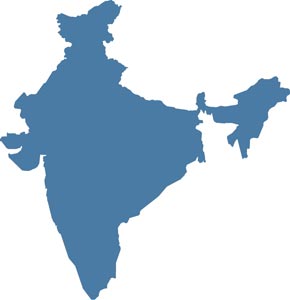Migration, Brain Drain, and Going Forward
By Jennifer Walker

The nursing shortage is a global shortage.
For countries like the United States and Britain, the national shortage can be alleviated by recruiting top-quality nurses from low-income and lower middle-income countries around the world.
In many ways, this international recruitment is valuable: in addition to being mutually beneficial for both hiring institutions and international nurses, it creates a more culturally diverse workforce, attracts professional immigrants to communities, and fosters a positive image of hiring institutions globally, according to Karen B. Haller, PhD, RN, Vice President for Nursing and Patient Care Services at The Johns Hopkins Hospital.
However, this practice also may be an obstacle to achieving the Millennium Development Goals—four of which directly relate to improving healthcare worldwide—by 2015, according to the International Council of Nurses (ICN).
“Migration is based on push and pull factors,” says Christine Hancock, who served as President of the ICN from 2001 to 2005. “There are factors that make people want to leave a country, and there are factors that attract people into a country.”
Julius Brigoli, BON ’07, Melissa Vista, Dina Krenzischek, and Fely Tanseco are four nurses who migrated from the Philippines to the United States, and now work at The Johns Hopkins Hospital. What drew them? Better pay, more opportunities for them and their families, and the chance to have a voice in the healthcare system. Yet their migration—along with thousands of other nurses worldwide—may mean that healthcare in their home country suffers from a lack of qualified staff known as “brain drain.”
A Better Paycheck
When Julius D. Brigoli, MSN, RN, and three of his siblings wanted to go to nursing school, his father sold the house they owned and moved into a rental property because college tuition must be paid up front. This high cost of education can put new nurses at a financial disadvantage, a disadvantage that Brigoli says is difficult to recover from if they decide to stay and work in the Philippines. (Melissa Vista says she has nursing friends who would work in hospitals for about $10 a month.)
So Brigoli came to the United States in 1992. He joined Johns Hopkins in 1993, where he worked his way up the ranks, eventually becoming a Nurse Clinician III.
Brigoli feels the government should have programs to encourage nurses to remain in the Philippines, but officials may have to do something about the low salaries first. “It’s like you’re living from paycheck to paycheck, nothing in between,” he says.
Wider Opportunities
In the Philippines, Melissa Vista, RN, graduated cum laude with a bachelor’s degree in nursing. She then worked with the Red Cross and international medical clinics and volunteered at a hospital before joining Johns Hopkins in 2002.
Today she is a Central Nursing Bed Coordinator, a position that isn’t available in the Philippines. She could have been a charge nurse or a head nurse, she says, but nurse educator positions do not exist in hospitals there. Her work hours and nurse-to-patient ratios are also better. “It’s nice to be able to take care of patients the way that they need to be [taken care of].” And, she points out, her son will have more career opportunities in the U.S. than he would have had in the Philippines.
Like Vista, Dina Krenzischek, PhD, RN, Nurse Manager for the Adult Same Day Prep and Post Anesthesia Care Units since 1982, doesn’t think she would have obtained the same level of success if she stayed in the Philippines.
“There are so many nurses; it’s much more competitive… it seems that you’ll never reach [the top] there because there are more senior nurses,” she says.
Even though she initially came for adventure, Krenzischek has enjoyed much career success in the U.S., serving as President of the American Society of Perianesthesia Nurses and co-founder of the Philippine Nurses Association of America Maryland Chapter.
A Voice in Healthcare
“Nursing back home…it’s still very much old school,” says Vista. “Whatever the doctor said, you did.”
That’s why Fely Tanseco, RN, had to learn to express her opinions when she started working in the U.S. Tanseco decided to work abroad because she wanted to travel and do something different. She joined Hopkins in 1976 and eventually became a Nurse Clinician III who feels comfortable telling physicians what she thinks.
“It’s not like the doctor ordered this, and we have to do this,” she says. “Here in the States, you can be assertive, you can question.”
Brain Drain and Going Forward
Hancock, the former President of the ICN, says there wasn’t much international concern about brain drain until nurses started migrating between countries. “There have been…a number of people making attempts to stop nurses from moving, and yet IT people have moved from places like India and China to developed countries [without causing international concern].”
Still, it may be those nurses with the best education who are leaving. In the Philippines, Vista says many of the nurses who stay are unable to pass the international nursing boards or do not have the resources to fulfill the international requirements. Because they have to take positions in the Philippines that don’t pay well, the quality of care can be affected.
So what can countries like the Philippines do to prevent their top-notch nurses from leaving?
“Treat them better. That’s a highly simple, low-cost thing,” Hancock says.
In the meantime, a silver lining to migration is that nurses may bring the skills they learned back to their home countries. The four Hopkins nurses have plans to do this in the future. For example, Vista wants to work with the Dean of her nursing school in the Philippines, who is pushing for a program that allows nurses to make more of an impact in the country’s health system. “My idea of nursing has evolved and changed,” she says. “I want to bring that [knowledge] back home. That’s what we’re moving towards.”

The Facts on Nurse Migration
- Although the U.S. employs the most international nurses by far, its percentage of foreign-born nurses employed in the health care system is only four percent, lower than the United Kingdom and Ireland (both 8%), as well as Canada (6%.)
- The top five countries that export nurses are the Philippines, Canada, India, Nigeria, and Russia/Ukraine.
- International nurse recruitment is not necessarily solving the U.S. nursing shortage. For example, even though 13% of nurses at The Johns Hopkins Hospital are foreign-born—four percentage points higher than the national average—only 25 international RNs have been hired each year on average since 2002.
Clari Scota, Brazil

“I was a social worker in Brazil…but I always liked the idea of being an RN. So after a year from my arrival in America, I decided to go to school to learn English because I did not speak any English when I came. After my English was just basic, I made the decision to go to nursing school. It was very difficult to adjust to the new way to learn, the American way, [especially] with my so basic English. But I survived and here I am…I found what I want to do for a living.”
Clari Scota, RN, arrived in the U.S. expecting to stay a year. That was 10 years ago. Along the way she found her calling as a nurse.
Shaila Chopde, India

“Nursing in India is different from JHH in many aspects…. [For example], information technology at Hopkins is an integrated and essential part of patient care. Technologically, India is still not as advanced in most hospitals, so nurses do a lot of hands-on patient care without the benefit of sophisticated instruments and devices… At Hopkins there is a narrower nurse-patient ratio in high-intensity areas such as the ICUs and ED, making it possible for nurses to spend more time on patient education… whereas in India, the nurse-patient ratio is extremely strained due to the huge nursing shortage.”
Shaila Chopde, RN, finished her nursing education in India, then came to the U.S. to join her parents. She worked as a clerical associate until she passed her boards.
Leonie Farrington, Ireland

“I see many differences [between nursing in the U.S. and in Ireland]. You receive an excellent orientation at Hopkins, which is not so back home. You are definitely a clinician in your own right; a lot more respect is afforded to you…Another notable difference is nurses’ involvement on many committees, both at the unit level and at the hospital, where their opinions are valued in order to make changes in the system. That’s very attractive to someone in our profession.”
Leonie Farrington, RN, came to the United States in 2005 to marry her husband, but always thought she would like working at Hopkins.